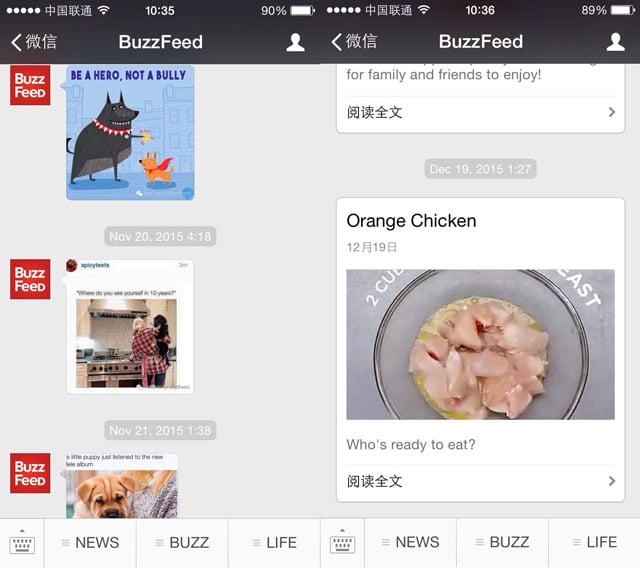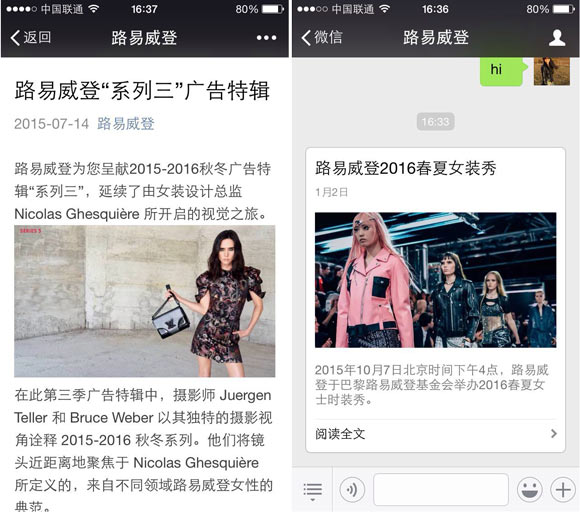5 ways brands failed at marketing themselves on WeChat… which are also 5 ways you can improve your own strategy.
1. BuzzFeed
Content on BuzzFeed is hardly sharable: the company is indeed using mostly pictures and videos which by definition are extremely difficult to share on WeChat (as opposed to the classic “news” articles).
By taking this approach, BuzzFeed is showing an almost stereotypical behaviour of foreign company localising its approach without having a second thought about it. Videos and images are indeed very appropriate for Facebook, where the website’s algorithm tends to favour them and give them high visibility for users.
But WeChat is played with completely different rules, and BuzzFeed seems to be ignoring them.

The videos themselves seem to be focused on cooking, quite unlike the traditional BuzzFeed approach.
Improvement: Instead of posting one comic image, post a serious of images in one article with a clear title (actually quite like the traditional BuzzFeed approach in Western countries)
2. Apple
Mistake: the company isn’t dealing with fake accounts.
Actually, Apple does not have official present on WeChat, but that doesn’t stop other people from registering accounts under Apple’s name, thus resulting in negative PR for the brand, and potential scams.

The problem would however be easy to fix.
On WeChat, you cannot delete an account once it’s been created. But you can “sue” accounts which are infringing on your name by submitting proof that you own that trademark (Chinese business license and Chinese trademark are generally sufficient).
Coca Cola is facing a similar issue, but not only because of fakes: because of its many subsidiaries.
Coca Cola has maybe 100 WeChat official accounts, each registered and verified under a Coca Cola subsidiary company. These accounts of course are struggling to maintain consistency, leading to inefficient PR and confusion among users.

It would also be possible (although more challenging) to solve this issue:
- Stop publishing on subsidiary accounts
- Change the account name to “not in service” . You can change the name of WeChat account when you verify the account.
- Change the profile picture to make it clear the “old” accounts are not in use anymore
- Leave only a few accounts each with a distinctive purpose. For example:
- A main account targeting general customers
- A service account targeting vendors
- A specific account for public relation and media
- An enterprise account for internal communication with different access control levels like factory workers, accounting department, HR, etc…
- Integrate the main WeChat account with a customer service backend to make it easy to assign the overwhelming number of customer messages to customer service representatives
- Send targeted messages to user group in different locations and customise the WeChat menu so that users in different locations will access only the information that’s relevant to them.
3. Nike
Mistake: content positioning is too promotional

The only thing on Nike’s WeChat account is its product. This may work on Instagram or Facebook, where users will simple glance through the news feed and skip to other post. But pure promotional content does not work on WeChat, even for popular consumer brand like Nike. It takes at least 2 clicks (or 3 clicks with subscription accounts) for followers to even open the post. Unless the content is interesting, useful or relevant, it’s easy for users to simply ignore all future posts or even unfollow the account.
How to fix it:
Once again, we are faced with an issue with pure localisation of content.
There is a clear need to adapt content to the very design of the APP on which it is designed. Foreign brands sometimes try to find direct equivalent between the West and China (Weibo with Twitter, WeChat with Facebook, Tmall with Amazon, etc…) but this strategy is usually extremely misleading.
Holistic platforms with WeChat can’t be compared with Facebook in a meaningful way: they do share common traits, but also completely different user experiences. And content, more than anything else, has to be a close fit to the UX.
NikeWomen, another of Nike’s accounts, is on the other hand doing great. Its content on physical training for women has fuelled the fast growth of the account since its creation.
4. Louis Vuitton
Mistake: poor product display

Louis Vuitton might be one of the most iconic high-end fashion brands. For their WeChat, they however went for the… the cheapest option. LV is simply using traditional WeChat messages with embedded pictures, where the brand’s competitors are building sleek H5 websites which put their products under the limelight.
How to fix this issue:
Build a customised WeChat website that follows the brand image. LV has been consistent about not compromising with user experience up to this point, so why do it on WeChat? Why simply go for the WeChat basic visual identity, when LV could build a website in line with their image?
5. Coca Cola
Mistake: WeChat website is not mobile responsive
As you click on the WeChat menu of Coca Cola’s WeChat website, you’ll be surprised it doesn’t scale properly and forces you to zoom-in in order to read content. Surprising, from one of the biggest consumer brands in the world.

How to fix:
Coca Cola can build a responsive website, but that’s not the end of the story. A good WeChat website will not only be responsive, but also specifically designed for WeChat.
Brands can build a WeChat website that leverage the specific features of the API: WeChat login, geo-location, shake function, sharing function. They will then leverage the tightly integrated nature of WeChat by smoothly taking users through the different parts of the applications, from content, to sharing… to sales.

